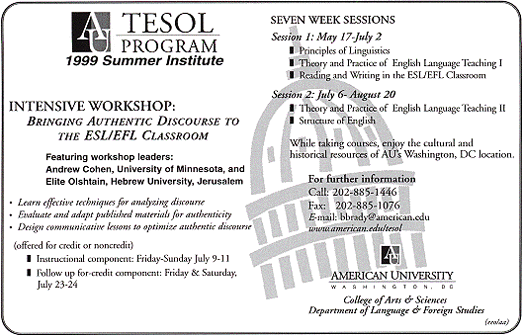|
|
Recent and Readable--Book Reviews
|
ESL/EFL Teaching: Principles for Success |
Ready-to-Use Conflict Resolution Activities for Secondary Students |
Freeman, Yvonne S. and David E. Freeman. ESL/EFL Teaching: Principles for Success. Portsmouth, NH: Heinemann (http://www.heinemann.com/code/template.ghc), 1998.
The Freemans begin with many commonsense assumptions about how a new language is learned. Unfortunately, many of these commonsense assumptions, the Freemans show, have proved in practice to be fragmented, dis-empowering, and not as effective as hoped. They briefly review the language teaching movements, orientations, and fads of this past century, and then reveal the approach of this book, which they call, somewhat pedantically, the sociopsycholinguistic orientation. That unfortunate term is chosen apparently to reflect both the social and individual psychological aspects of language learning, a view that takes into account the insights of Piaget, Vygotsky, Chomsky, and Rosenblatt.
Terms aside, the book is valuable for putting together a number of thoughtful principles that the authors show to be grounded in what we know of how people learn language and use language to fulfill needs.
Simple, yet profound. These are the principles: 1) Learning proceeds from whole to part. 2) Lessons should be learner-centered. 3) Lessons should have meaning and purpose for students now. 4) Lessons should engage students in social interaction. 5) Lessons should develop both oral and written language. 6) Lessons should support students' first languages and cultures. And 7) Lessons should show faith in the learner to expand students' potential.
The authors go on to provide abundant examples of how to put these principles into practice in daily lesson planning. The book is geared mainly to K-12 instruction, with some examples drawn from adult education. I found myself wishing that more of the book spoke to college level instructors' needs. However, applying principle number 7, above, I approach the book with faith in myself and in the principles taught. And I find that I can use those principles to create my own examples.
Perlstein, Ruth, and Gloria Thrall. Ready-to-Use Conflict Resolution Activities for Secondary Students. West Nyack, New York: The Center for Applied Research in Education (Available through Prentice-Hall), 1996.
How might conflict management education be appropriate for English language learners? One reason is simply pragmatics. Moving into a new language and culture, a person needs to have the communication skills necessary to deal with uncomfortable situations. Another is the conflict inherent in differing cultural expectations. Thus our teaching environments, if they are lively ones, are likely aglow with conflicts, both hidden and overt ones.
Although this book is not directed toward English learners, an astute ESOL teacher will readily see classroom potential in the reproducible material in this huge, spiral-bound, 349-page book. Loads of role-playing scenarios, simply-outlined communication steps, stories for reflection and discussion, and more. The language teacher will know what to define, what to practice, what to emphasize for language development.
The Editor
|

|
WVTESOL Newsletter Editor: Linda Yoder Copyright 1999 by WVTESOL
|
